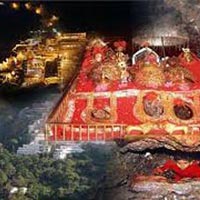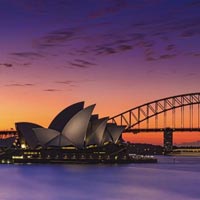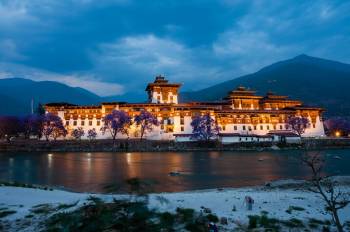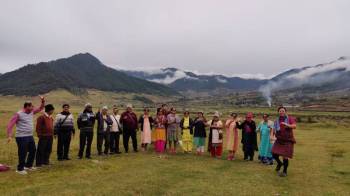9 Nights / 10 Days

If you don’t have a lot of time but you want to see all the highlights of Central Bhutan, this is the perfect trip for you. You start in the small, pleasant capital city of Thimpu, then you head to the Bumthang Valley, passing through perhaps the most beautiful landscapes of the country. Bumthang is ideal for entertaining, reasonably-easy walks. In the nearby valley of Phobjika from mid-October to April you can see the rare black-necked crane, but the valley is worth visiting even if it’s not crane season. In Paro you will visit the famous Tiger's Nest Monastery which is impressively perched high on a mountainside. We recommend that you plan your travel dates you can experience a festival in Bhutan, a colorful highlight of any trip.International flights
Tips and gratuities
Drinks
Personal expenses
Peakseason surcharge (March May, Aug Sep) € 400,
Optional hotel upgrade (see hotels tab)
You will arrive in Paro by plane. If you are coming from Delhi / Kathmandu, it is a fabulous flight across - nearly through - the Himalayas. In clear weather, the view extends from the Karakorum Mountain Range deep into Tibet. You see giant mountains like Mount Everest (8848 m) on the border of Nepal and Tibet and Kanchenjunga (8598 m) in Sikkim. For the best view ask for a window seat on the left when traveling from Delhi to Paro. When you arrive at the small, stylish Paro Airport you will be met by the Bhutanese guide and driver who will accompany you on your tour through Bhutan. From Paro you will drive several hours to Thimpu, the capital of Bhutan. Although Thimpu is now a real city-it is the only place in Bhutan with traffic-it still has the feel of a small village. During your stay in Thimpu, you will get a chance to attend an archery competition. Archery is the national sport in Bhutan and competitions are always well-attended. You can also visit one of the many monasteries or the National Peace Chorten (a Buddhist shrine). It's also nice to walk around the city and visit some of the many shops, or just sit on a bench in a square and watch the comings and goings of day-to-day life. Of course, you can also visit the impressive Dzong Thimpu where you will find the rooms of the king, whose palace is situated diagonally opposite the dzong. The security for visiting the Dzong Thimpu is therefore much stricter than elsewhere in the country.
A dzong is a fortified settlement that houses both spiritual and worldly powers, a kind of abbey and local government combined. When entering the dzong, Bhutanese men have to wear traditional clothing and leather shoes, as well as a traditional scarf that displays their civil or official rank. Although nowadays tourists are able to enter most dzongs, there are always areas that are closed to the public. Fortunately, there is much you can admire from the courtyards. Tourists do not have to adhere to a dress code, but of course you should be dressed decently.
Today you can take a walk to the monasteries of Cheri and Tango. You begin with a short car ride to where the road splits into two routes, one leading to each monastery. From this point you can continue on foot. Both monasteries are about an hours’ walk (two hours there and back). The Tango monastery was built by the 'Divine Madman' and the Cheri monastery is in a beautifully rustic area. At the end of the day you can visit the small zoo, located on the outskirts of the city. The zoo is dedicated to the national animal of Bhutan, the takin, which is a unique creature that is a deer-like variant of the wildebeest. If you are in Thimpu over the weekend, you can also visit the lively weekend market.
From the Thimpu Valley you begin the ascent to the Dochu La Pass (3140 m), which is not only dotted with stupas and prayer flags, but also has stunning views of the Himalayas. You will then cross the Pele La Pass (3420 m) which offers you a nice view of the Black Mountains and is usually dotted with yaks. From the Pele La Pass you have the option of taking a detour to the Phobjika Valley, a beautiful, large valley famous for the rare black-necked cranes that live there in winter (mid-October to April). You can visit the crane center and get a close-up view with their high-powered telescopes. Phobjika also lends itself well to short walks through the woods and the valley. Alternatively, you can go to the village of Gangtey and visit the small monastery there. Usually you spend the night in the picturesque Dewachen Hotel that boasts stunning views and a cozy atmosphere. Rooms are equipped with wood stoves that keep them warm in the cold winter months. In busy periods (around festivals and during crane season) it may happen that the hotel is not available and the route must be modified. Alternative accommodations include a homestay with a family in a simple farmhouse or in a fairly luxurious tented camp.
Today you exchange the valley of Phobjika for that of Bumthang. It is a 3-hour drive from Phobjika to Trongsa. After an hour you will drive by the chorten of Chendebji, a Nepalese Buddhist monument which is strongly reminiscent of the Swayambunath Stupa in Kathmandu. A little further along the road you will be able to see Trongsa, but it takes a while before you're actually there because the road winds along the treacherous mountainsides. Immediately after Trongsa the road begins rising to the Yotong La Pass (3425 m), an hour uphill. From there it's two hours to the Bumthang Valley, where you spend the night in the town of Jakar. Bumthang is a collective name for four valleys in central Bhutan: Chökhor, Tang, Ura and Chumey. The main attractions are found in Chökhor, and often when people say Chökhor they mean Bumthang. From Jakar you can take nice walks through the valley and visit several monasteries en route. The village itself is also worth walking through, and there are many shops and restaurants to visit
Today you can go hiking through the valley and visit some monasteries. Of course, private transportation to the monasteries is also available for those who prefer not to walk. You will first visit the Kurjey Lhakhang, an impressive monastery consisting of three temples. In one of the temples is a sacred cave where the patron saint of Tibet, Guru Rinpoche, meditated after he defeated the demons and brought Tibetan Buddhism to Bhutan. A walk of about two hours takes you back to Jakar via several more monasteries, the Tamshing Goemba and Konchogsum Lhakhang. You can also walk around the town and visit the local Jakar Dzong where you have a beautiful view over the valley.
Today you will return to Trangsa via the same route by which you came. You will arrive in the afternoon and have a chance to visit the dzong. The Trongsa Dzong is the largest in the country and is beautifully situated high up on the mountain. Everywhere you look from here you have a beautiful view. The dzong is an active administrative and religious center and is therefore not always open to the public, but it is impressive to see from the outside, and you are able to visit the watchtower beside the dzong. The village itself is also fun to stroll through.
Today you travel back to Western Bhutan on the main road that runs through the country. From here it is 4 hours to Punakha where the dzong is immediately visible. It is one of the most picturesque and important dzongs in the country, beautifully situated at the confluence of two rivers. Because Punakha is at a much lower elevation than Thimpu it is usually much warmer. For centuries it also served as a winter residence for the royal family, and the Punakha Dzong continues to be the where the religious center of Thimpu moves in the winter. With a little luck you can go inside to admire the prayer hall. Not all areas are always open to the public, but there is always plenty to see. The Punakha Valley is famous for the red rice that is grown here. This rare type of rice can only be harvested once a year. Just outside the village is the Chimi Lhakhang Monastery built by the “Divine Madman,” a legendary figure from Bhutanese history. He was convinced that a life of debauchery and pleasure was the way to reach nirvana. All over the country you will see phallic symbols painted on the walls and doors of houses, a reminder of the wild love life of this popular saint of Bhutan. The walk to the monastery is about half an hour from the road. You will spend the night in Punakha or in nearby Wangdue.
In the morning you can choose to visit the Wangdue Dzong. Then you will drive five hours to Paro, a small provincial town situated in the beautiful Paro Valley. On the outskirts of the village is the imposing Paro Dzong, a square building that you enter via a drawbridge. It was the setting for the famous Bernardo Bertolucci film Little Buddha. Just above the dzong is the National Museum, housed in the old watchtower (ta dzong). It is an interesting museum that gives a nice overview of the history and daily life in Bhutan. The village is charming, with lots of teahouses and small shops, and the fields around Paro are full of people working and practicing archery.
Not far from Paro is Taktshang Goemba, or the Tiger’s Nest Monastery. Due to its spectacular location perched on a steep rock face, this is by far the most famous monastery of Bhutan. It is a beautiful but strenuous hike to reach the monastery, as the trail is almost entirely uphill. After about an hour you reach the first lookout point at the teahouse. Here you can have a drink while enjoying the view of the convent across the street. There is also the option of going as far as the teahouse on horseback, but this needs to be discussed well in advance with your guide. From the teahouse you can continue the hike to visit the monastery itself. The path eventually leads to a set of stairs carved into the mountain surrounded by fluttering prayer flags. When entering the monastery, you must give up your purse and camera because photography is not allowed inside. You should also be respectfully dressed, which means no bare arms or legs, and preferably nothing tight-fitting. Make sure you keep some change ready, so you can make a small donation in the temples, just like the locals. You can visit various rooms in the monastery, including the cave where Guru Rinpoche meditated for three months. During a fire in 1998 large parts of the monastery were destroyed, but the cave remained miraculously undamaged. The monastery has since been completely rebuilt.
Today you will be returned to the Paro Airport.
Depending on your travel plans you can fly to Delhi, Kathmandu, Kolkata, or who knows? To Bangkok?
| No of pax | Age Limit | Price per pax (Rs) |
|---|---|---|
| Adult | Above 12 years | $ 1995 / Adult |
We are Dealing in Tour & Travels Services. Read More...
1,71,570 PP

 10D/9N
10D/9N
Srinagar - Anantnag - Patnitop - Jammu - Baramulla
 10D/9N
10D/9N
 10D/9N
10D/9N
New Delhi - Varanasi - Bodhgaya - Rajgir - Nalanda - Patna - Vaishali - Kushinagar ..
 10D/9N
10D/9N
 10D/9N
10D/9N
Kinnaur - Kaza - Spiti Romantic Package
Chandigarh City - Shimla - Kinnaur - Kaza - Digboi
 10D/9N
10D/9N
 10D/9N
10D/9N
South India - Kerala & Tamil nadu- 9 N/1..
Kovalam - Munnar - Alleppey - Madurai - Kochi - Kumarakom Thekkady
 10D/9N
10D/9N
 10D/9N
10D/9N
Tawang Kaziranga Shillong Tour
Guwahati - Shillong - Tawang - Kaziranga - Cherrapunji
 5D/4N
5D/4N
 7D/6N
7D/6N
6 Nights/ 7 Days - Bhutan Happiness Tour
Punakha - Bumthang - Paro - Thimphu - Phobjik
 7D/6N
7D/6N
 20D/19N
20D/19N
20 Days Land Package Country Tour BHUTAN..
Punakha - Paro - Phuntsholing - Bagdogra - Bumthang - Mongar - Trashigang - Trongsa..
 4D/3N
4D/3N
 6D/5N
6D/5N
 7D/6N
7D/6N